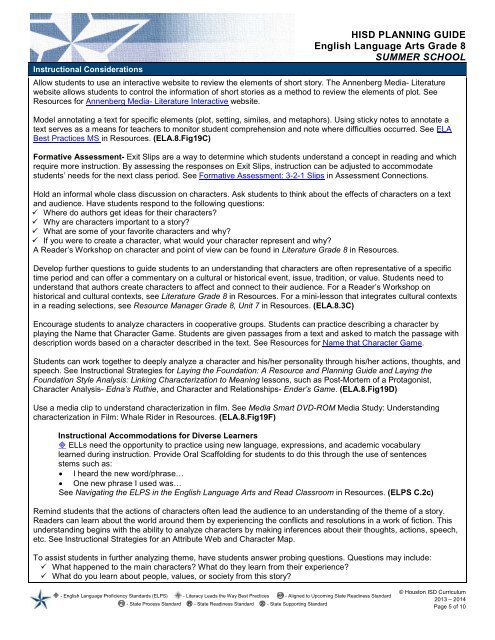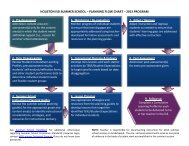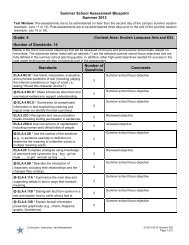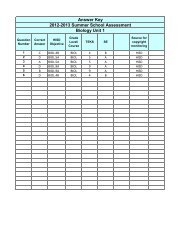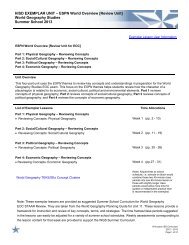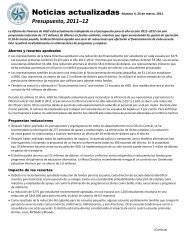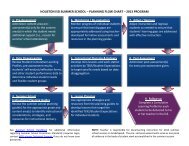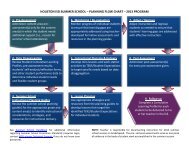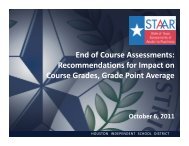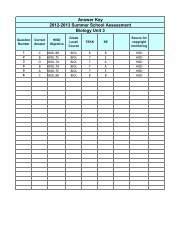SSK Unit 4.2 Planning Guide
SSK Unit 4.2 Planning Guide
SSK Unit 4.2 Planning Guide
Create successful ePaper yourself
Turn your PDF publications into a flip-book with our unique Google optimized e-Paper software.
Instructional ConsiderationsHISD PLANNING GUIDEEnglish Language Arts Grade 8SUMMER SCHOOLAllow students to use an interactive website to review the elements of short story. The Annenberg Media- Literaturewebsite allows students to control the information of short stories as a method to review the elements of plot. SeeResources for Annenberg Media- Literature Interactive website.Model annotating a text for specific elements (plot, setting, similes, and metaphors). Using sticky notes to annotate atext serves as a means for teachers to monitor student comprehension and note where difficulties occurred. See ELABest Practices MS in Resources. (ELA.8.Fig19C)Formative Assessment- Exit Slips are a way to determine which students understand a concept in reading and whichrequire more instruction. By assessing the responses on Exit Slips, instruction can be adjusted to accommodatestudents’ needs for the next class period. See Formative Assessment: 3-2-1 Slips in Assessment Connections.Hold an informal whole class discussion on characters. Ask students to think about the effects of characters on a textand audience. Have students respond to the following questions: Where do authors get ideas for their characters? Why are characters important to a story? What are some of your favorite characters and why? If you were to create a character, what would your character represent and why?A Reader’s Workshop on character and point of view can be found in Literature Grade 8 in Resources.Develop further questions to guide students to an understanding that characters are often representative of a specifictime period and can offer a commentary on a cultural or historical event, issue, tradition, or value. Students need tounderstand that authors create characters to affect and connect to their audience. For a Reader’s Workshop onhistorical and cultural contexts, see Literature Grade 8 in Resources. For a mini-lesson that integrates cultural contextsin a reading selections, see Resource Manager Grade 8, <strong>Unit</strong> 7 in Resources. (ELA.8.3C)Encourage students to analyze characters in cooperative groups. Students can practice describing a character byplaying the Name that Character Game. Students are given passages from a text and asked to match the passage withdescription words based on a character described in the text. See Resources for Name that Character Game.Students can work together to deeply analyze a character and his/her personality through his/her actions, thoughts, andspeech. See Instructional Strategies for Laying the Foundation: A Resource and <strong>Planning</strong> <strong>Guide</strong> and Laying theFoundation Style Analysis: Linking Characterization to Meaning lessons, such as Post-Mortem of a Protagonist,Character Analysis- Edna’s Ruthie, and Character and Relationships- Ender’s Game. (ELA.8.Fig19D)Use a media clip to understand characterization in film. See Media Smart DVD-ROM Media Study: Understandingcharacterization in Film: Whale Rider in Resources. (ELA.8.Fig19F)Instructional Accommodations for Diverse Learners ELLs need the opportunity to practice using new language, expressions, and academic vocabularylearned during instruction. Provide Oral Scaffolding for students to do this through the use of sentencesstems such as:• I heard the new word/phrase…• One new phrase I used was…See Navigating the ELPS in the English Language Arts and Read Classroom in Resources. (ELPS C.2c)Remind students that the actions of characters often lead the audience to an understanding of the theme of a story.Readers can learn about the world around them by experiencing the conflicts and resolutions in a work of fiction. Thisunderstanding begins with the ability to analyze characters by making inferences about their thoughts, actions, speech,etc. See Instructional Strategies for an Attribute Web and Character Map.To assist students in further analyzing theme, have students answer probing questions. Questions may include: What happened to the main characters? What do they learn from their experience? What do you learn about people, values, or society from this story? - English Language Proficiency Standards (ELPS) - Literacy Leads the Way Best Practices - Aligned to Upcoming State Readiness Standard- State Process Standard R - State Readiness Standard S - State Supporting Standard© Houston ISD Curriculum2013 – 2014Page 5 of 10


